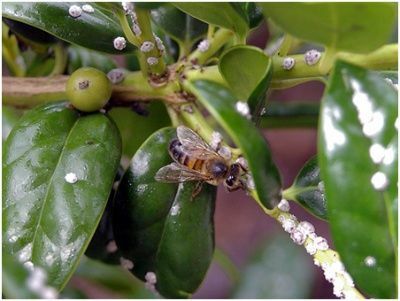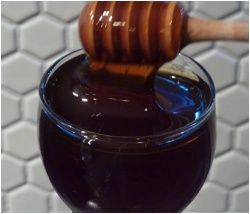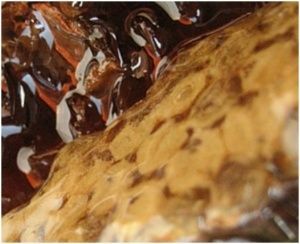With the onset of cold weather, during a period of frequent rains and other unfavorable weather conditions, the flower nectar ceases to stand out. And then the indefatigable bees are taken for collecting the sweet - sweet excretions from plants and insects.
Honey obtained from such nectar is called padeev. Viscous, a sugar substance of dark brown color contains a huge amount of minerals and salts. Despite the fact that padego honey is considered a second-rate product, it has a wide range of useful actions and acts as a remedy for many ailments.

What is a product from the pad
Sources
Pad, which serves as the basis for medicinal honey, is found in nature in two forms:
- Honey dew is a sweetish liquid producedleaves of trees and shoots of plants. Among the plant sources of the fall are: spruce, pine, oak, elm, maple, larch, fir, linden, rose.
- Animal waste products( excrement) that contain recycled plant juice. Sources of animal origin are Medvedi, leaf-blocks, chervets, aphids.
Color, smell, taste characteristics

Honey paste is a variety of color shades: black and dark brown( collected from leaves), dark green and yellow-orange( made from pine needles).
Light honey is not so common - in spring and early summer. The aroma of the product is ambiguous, unlike ordinary honey, fragrant with floral notes, it can have a sharp, even slightly unpleasant smell or not smell at all.
Consistency of honeydew honey - syrupy, dense, viscous, long not melting in the mouth. The taste is sweet, with barely discernible hints of bitterness.
Chemical Composition
The chemical composition of the product is heterogeneous. It contains mineral salts( phosphorus, manganese, cobalt, iron), organic substances, nitrogen-protein compounds and phytoncides( natural antibiotics).The given chemical compounds padego honey contains in decent doses, therefore its advantage for the person is more significant, rather than the action of the flower analogue.
Healing properties
As well as floral, honey from padi can be used in cooking, but it is much more rational to use it for medicinal purposes. In addition, when the product is heated, the useful substances contained in it evaporate.
Warning! Honey paste has antibacterial and antimicrobial effect, it is prescribed as a therapeutic and preventive agent. It is indispensable for colds, insomnia, kidney and liver diseases. Its anti-stress and soothing properties are high.
The product is also used as food supplements with a deficiency in the body of iodine, calcium, fluorine and magnesium. The result of bee activity is especially useful for people who have experienced serious injuries. And this is not all that a honey can do.
Its useful properties are appreciated by the perfumers, confectioners and physicians who actively use the product for various purposes. A pleasant taste of honey, together with a bouquet of medicinal qualities make it one of the most popular means, prepared by nature itself.
Important! The effect of honeydew honey on bees is fatal. When using this product, they can get sick with nosematosis( a disease of the digestive organs), stop laying eggs, and then completely die.
If honey is left for the winter in the hives, it can lead to the death of the whole bee family. The reason for this is an increased content of mineral salts, dextrins and nitrogenous compounds in the fall, which negatively affect the body of bees.
Interesting features of honeydew honey
Pad bees are collected mainly in the highlands and coniferous-deciduous forests. The product from the fall is rarely clean, often it contains a small fraction of the flower honey. If there is not enough paddy, the bees connect it with the flower nectar, creating a mixed honey at the output. At the same time, the properties of pure and mixed products differ significantly - the consistency of the latter is less dense, and the color is lighter.
The padding honey and its features are directly affected by factors such as:
- species of plants and insects that emit decay;
- climatic conditions of the area;
- collection time;
- minerals present in the pada.
Pad honey is more viscous than floral honey, about the same sweetness with it, except for some species with an acidic or bitter taste. The smell of a product produced from insect feces is hardly distinguishable, and sometimes completely absent, whereas honey, collected from honey dew, may not be very pleasant, specific flavor.
Warning! In the animal waste there are much more protein substances, useful acids and mineral salts.
Pad or flower nectar? Or how to distinguish one species from another
In the West, the product we are considering is more in demand than floral. In Europe and America have already managed to evaluate its exceptional healing properties. On the territory of the post-Soviet space, it is not so popular, and many people still do not know what useful padem honey is and how to distinguish it from other varieties. Let us consider this fact in more detail.
5 characteristic features of padom honey
- The product is characterized by pronounced shades of bitterness in the aftertaste, light notes of malt, increased viscosity.
 It differs from the flower counterpart with taste, color, odor and consistency
It differs from the flower counterpart with taste, color, odor and consistency - Color - intense amber, dark brown, light orange, dark green, almost black, resembling the appearance of tar. About why this honey gets dark color, we told in the article: Dark honey - what affects the color.
- The smell is peculiar, spicy with a barely perceptible bitterness sound.
- The composition of honey is unstable, hygroscopic, subject to rapid souring, especially if it is not sealed in honeycombs.
- The product often crystallizes, converting to a fine-grained mass with a liquid fraction. Honey of dark shades undergoes crystallization to a lesser extent because of the presence of polysaccharides in it.
Honey paste, despite its useful properties, yet - a product for an amateur. People who prefer sweet, do not echo the bitterness of delicacies, are unlikely to become his fans. Does not inspire much and its specific flavor. However, if you close your eyes to the taste qualities, the product from the pad will be able to heal dozens of diseases.
